I’ve been thinking again about the tension of living between the quiet voice and the urgent alarm. If you lived in Hawaii this past weekend you’d still have alarm withdrawal going on in your psyche. Nobody would say we shouldn’t have blaring alert systems, even after one misfired and people panicked. But we cant live with the heightened noise level that seems to be so much of the modern “reality show” of life in this nation now. I don’t know how I would have handled the alarm, but I know I would have prayed.
With some friends a while back, we were looking at images at an exhibit, when each phone in each pocket started echoing an Amber Alert. Beyond the walls, someone was in real trouble. Devices were pulled out, screens looked at, a couple prayers whispered. . . and then silence. The phones were put away, some turned off. The alarm was frightening; the quiet voices in response much more sustaining.
There are two very different realities going on in our time. One is slow, steady and uncelebrated. The other is an irritating, very troubling scramble for attention. One is loud and obnoxious. We all hear it. We’re all sick of it. There’s another sounding, but you have to tune your ears to hear it
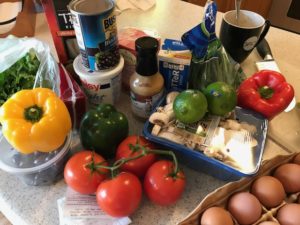 I slammed my computer closed this morning. The click-bait headlines have me so wearied, sickened. You can point fingers, but we’re all in this thing together. So, I did the next thing in my little life. I went to the grocery store. I had to do this anyway today, but I got there early and started to relish the simple tasks of handling and selecting real live things that will make a difference in our well being this week. I got to choose. I chose to enjoy the steps, the colors, the kindness of the produce man. I don’t think I have ever enjoyed a grocery trip more! I came home with several bags of supplies, and arranged some on my counter like a Dutch still life. Art is not imitating life here. Real life was already happening. You could rather say Life is imitating art of a sort. This is some of the gleanings I’ll use up this week.
I slammed my computer closed this morning. The click-bait headlines have me so wearied, sickened. You can point fingers, but we’re all in this thing together. So, I did the next thing in my little life. I went to the grocery store. I had to do this anyway today, but I got there early and started to relish the simple tasks of handling and selecting real live things that will make a difference in our well being this week. I got to choose. I chose to enjoy the steps, the colors, the kindness of the produce man. I don’t think I have ever enjoyed a grocery trip more! I came home with several bags of supplies, and arranged some on my counter like a Dutch still life. Art is not imitating life here. Real life was already happening. You could rather say Life is imitating art of a sort. This is some of the gleanings I’ll use up this week.
I think of the Northern European “vanitas” paintings, where commodities (due to increased trading and middle class means) would be arranged in a collection, then painted in oil. The intention of vanitas, was to show symbolically that the everyday things (like an orange half peeled) were all stand-ins for moments in time. And bigger than that was the idea that the temporal things would decay but the moment would be marked as a time of reflection and joy. That’s small voice stuff. That’s the kind of thing that reality shows can’t show you.
Come tomorrow. Come what may. I’ll be listening for the quieter voice.
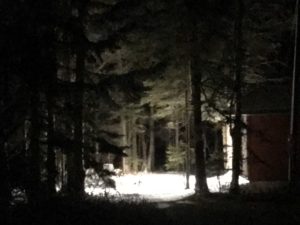 The last image of the year is one my husband shot out our tiny cabin window. The garage light was on, and all was still on the darkest night of the year in the Northland where my grandparents settled long ago. The frigid air, the wild vunerability of this backwater place and the mystery of light penetrating, so surgically into enveloping darkness was what moved us both with this digital glimpse. This is only a token, an illustration, of a sublime reality. I’m thinking of a baby born on another dark night, in another backwater place, where light burst forth into their precarious situation. John’s gospel says at the beginning “light shines (present tense) into the darkness, and the darkness did not comprehend it.” John 1:5
The last image of the year is one my husband shot out our tiny cabin window. The garage light was on, and all was still on the darkest night of the year in the Northland where my grandparents settled long ago. The frigid air, the wild vunerability of this backwater place and the mystery of light penetrating, so surgically into enveloping darkness was what moved us both with this digital glimpse. This is only a token, an illustration, of a sublime reality. I’m thinking of a baby born on another dark night, in another backwater place, where light burst forth into their precarious situation. John’s gospel says at the beginning “light shines (present tense) into the darkness, and the darkness did not comprehend it.” John 1:5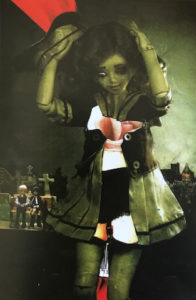 But then, I noticed a diminutive collage, chosen as a favorite by the museum staff, “Art to Stop Traffic: What Mercy Requires of Us”. The piece is only 5”x 3.5”. This submission is a poignant contrast, rendered from found images, paper, pen and pencil. The value and color contrast is immediately obvious, but peering closer one sees the uncomfortable juxtaposition of plastic expressions, skin color, garish lighting, things hidden and things exposed.
But then, I noticed a diminutive collage, chosen as a favorite by the museum staff, “Art to Stop Traffic: What Mercy Requires of Us”. The piece is only 5”x 3.5”. This submission is a poignant contrast, rendered from found images, paper, pen and pencil. The value and color contrast is immediately obvious, but peering closer one sees the uncomfortable juxtaposition of plastic expressions, skin color, garish lighting, things hidden and things exposed.
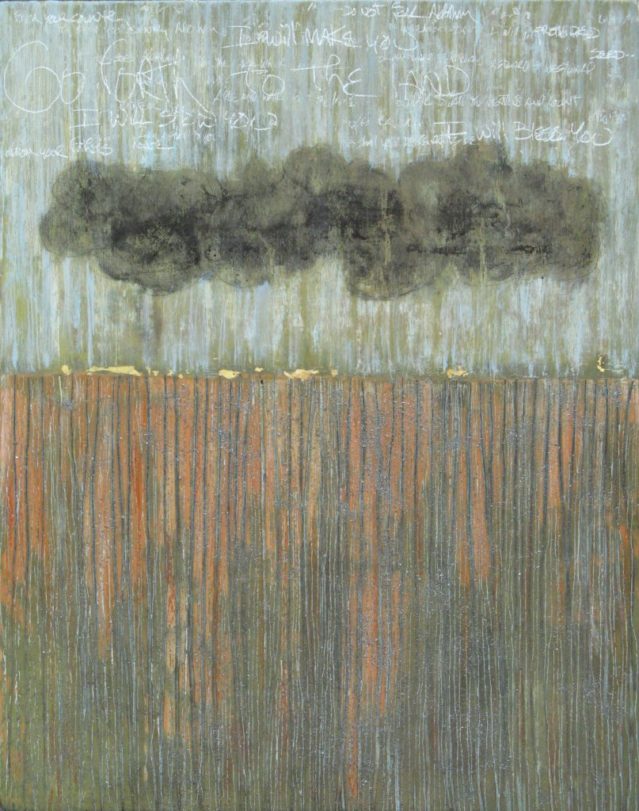
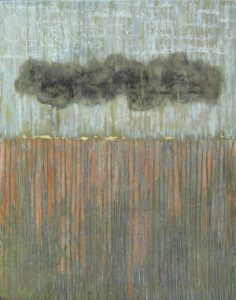 I don’t think it is a very pretty piece, and therefore, to me, all the more true.
I don’t think it is a very pretty piece, and therefore, to me, all the more true.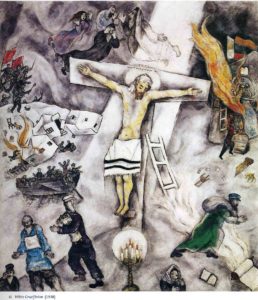 This piece startled me. Unmistakably Chagall, unmistakably modern, while being uncharacteristically direct as a narrative. I was already thinking about targets, about careful communication with the viewer (see last post). And then this. Chagall nails it. And he wants to make sure you can see it too.
This piece startled me. Unmistakably Chagall, unmistakably modern, while being uncharacteristically direct as a narrative. I was already thinking about targets, about careful communication with the viewer (see last post). And then this. Chagall nails it. And he wants to make sure you can see it too.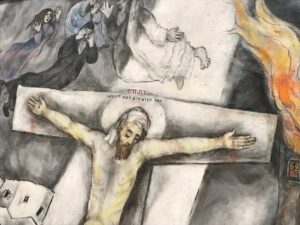
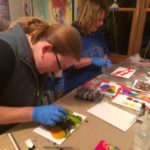
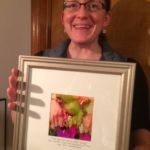 Voila, or “There it is!” was the result after a couple hours of experimentation. We really are creative whether we understand how we’re made or not. The excitement in getting a glimpse of that is contagious. This finished result was just one of several little gems made that night. Liz illuminated a favorite quote from Brenda Ueland’s “If You Want to Write”: “Since you are like no other being ever created since the beginning of time, you are incomparable.”
Voila, or “There it is!” was the result after a couple hours of experimentation. We really are creative whether we understand how we’re made or not. The excitement in getting a glimpse of that is contagious. This finished result was just one of several little gems made that night. Liz illuminated a favorite quote from Brenda Ueland’s “If You Want to Write”: “Since you are like no other being ever created since the beginning of time, you are incomparable.”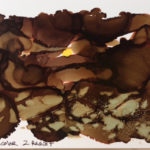
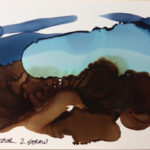 I am inserting here two little experiments with some inks for a workshop I’ll be conducting next week. Beginners will be introduced to some of the rationale behind abstraction’s promise. If some good work shows up from some of these craftsmen, I’ll be sure to post.
I am inserting here two little experiments with some inks for a workshop I’ll be conducting next week. Beginners will be introduced to some of the rationale behind abstraction’s promise. If some good work shows up from some of these craftsmen, I’ll be sure to post.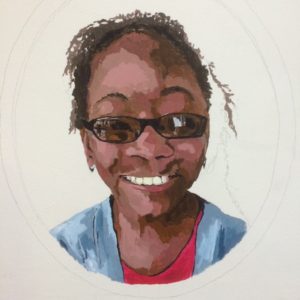 I’m getting some expert help on the mural project we are spearheading for a local non-profit. But this face I reserved to do myself. This little girl is precious, with big ideas, so she is being placed on one of the most important parts of the wall. I love her funky glasses. I love most the reflection out from her eyes and even off the plastic lenses. That was really, really fun to paint!
I’m getting some expert help on the mural project we are spearheading for a local non-profit. But this face I reserved to do myself. This little girl is precious, with big ideas, so she is being placed on one of the most important parts of the wall. I love her funky glasses. I love most the reflection out from her eyes and even off the plastic lenses. That was really, really fun to paint!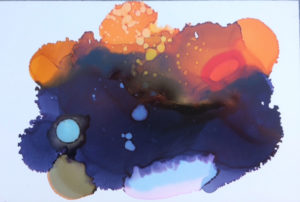 I struggle with my own voice in my work, living as I do in such a time of disintegration. I cannot make the work of my hands “say” what I hold in my heart so often. It is not my goal to be literal, but it is a desire to lift the viewer’s eyes. A friend of mine who is a photographer, grieving deeply over the death of her husband is now doing the best work of her career. We talked of this: why are we doing this work, this searching with images? Is it meaningful, is it what we “should be doing”? We got this far in our discussion: this work is an exploration into JOY. This expression is as fleeting as a sunset and as mysterious as a bird’s flight, but it is necessary, if even just for us. I have some ability to look, and to craft. Maybe through the work of my own hands others will see meaningfully also. For this, I keep on.
I struggle with my own voice in my work, living as I do in such a time of disintegration. I cannot make the work of my hands “say” what I hold in my heart so often. It is not my goal to be literal, but it is a desire to lift the viewer’s eyes. A friend of mine who is a photographer, grieving deeply over the death of her husband is now doing the best work of her career. We talked of this: why are we doing this work, this searching with images? Is it meaningful, is it what we “should be doing”? We got this far in our discussion: this work is an exploration into JOY. This expression is as fleeting as a sunset and as mysterious as a bird’s flight, but it is necessary, if even just for us. I have some ability to look, and to craft. Maybe through the work of my own hands others will see meaningfully also. For this, I keep on. But we had to think forward now. We knew that if we made it to our own street we would never make it up the hill. I coached the man behind the wheel that we best park on the flat spot and walk that last way home. He is a determined man. I have been by his side over 4 decades. So we kept on going and incredibly swerved up the hill getting ready to negotiate the last turn. And there it was ahead, as if she was expecting us. Our neighbor, with the much flatter driveway had her garage door open, space made available for our truck. Her big light was on and she was beckoning us forward. We laughed again, “how come we’re so lucky?” “how come we’re not in a ditch also?” There is no good answer. And so my non-religious neighbor got out an antique hymnbook and the three of us sat at her table and sang. This is unexpected joy.
But we had to think forward now. We knew that if we made it to our own street we would never make it up the hill. I coached the man behind the wheel that we best park on the flat spot and walk that last way home. He is a determined man. I have been by his side over 4 decades. So we kept on going and incredibly swerved up the hill getting ready to negotiate the last turn. And there it was ahead, as if she was expecting us. Our neighbor, with the much flatter driveway had her garage door open, space made available for our truck. Her big light was on and she was beckoning us forward. We laughed again, “how come we’re so lucky?” “how come we’re not in a ditch also?” There is no good answer. And so my non-religious neighbor got out an antique hymnbook and the three of us sat at her table and sang. This is unexpected joy.